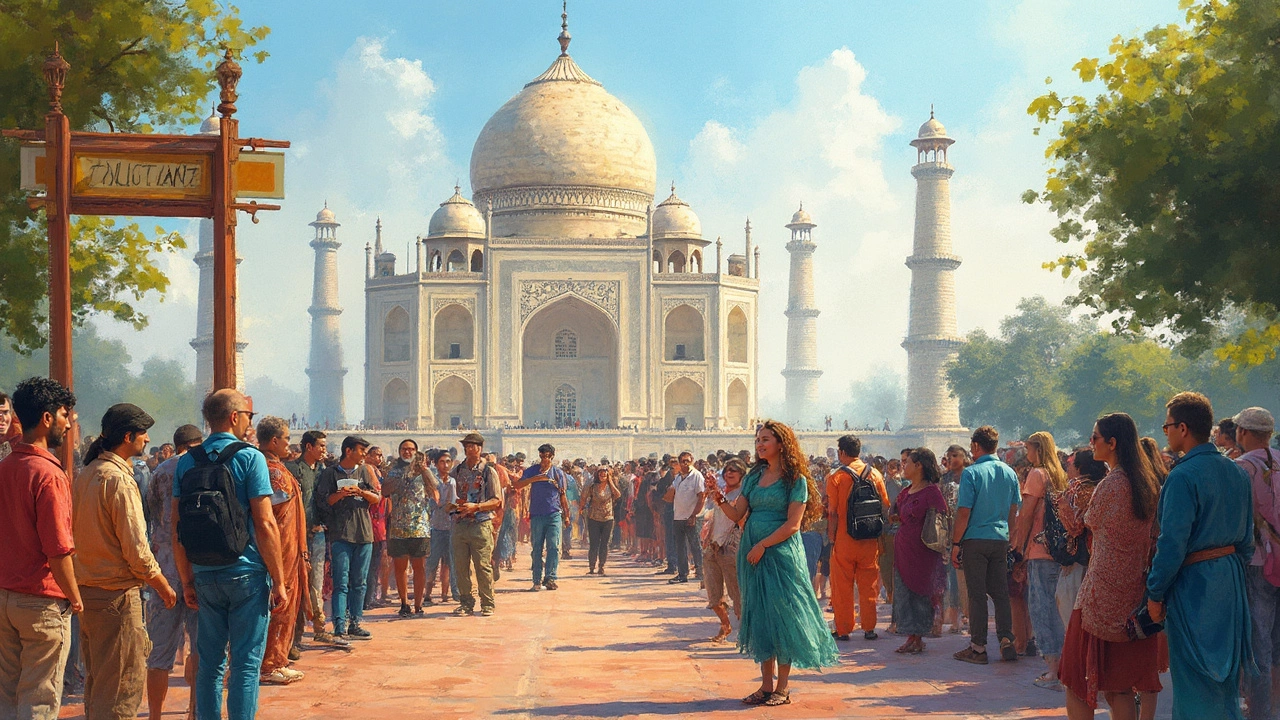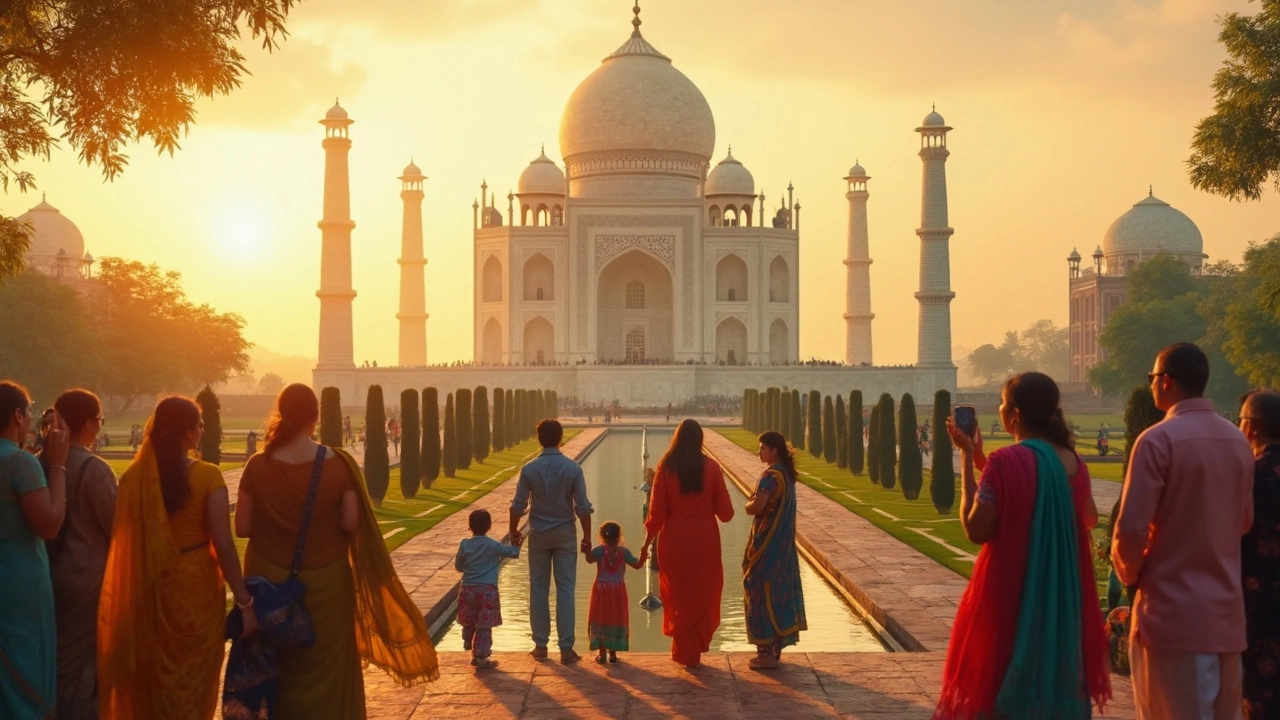When it comes to world-famous heritage sites, most folks instantly think of the Taj Mahal. And guess what? They’re onto something. The Taj Mahal isn’t just India’s most iconic monument—it also grabs the crown as the country’s most visited UNESCO World Heritage Site, clocking millions of visitors each year. It’s the kind of place that pops up in movies, Instagram feeds, and travel wishlists everywhere.
But why is the Taj Mahal such a magnet for travelers? It’s not just about snapping a selfie in front of that marble wonder. It’s the mix of jaw-dropping architecture, moving backstory, and the sheer scale that keeps people coming. Plus, it’s fairly easy to reach thanks to trains, planes, and buses linking Agra to every big city. Visiting this spot is almost a rite of passage if you’re seeing India for the first time—or even the fifth.
- What Makes a UNESCO Heritage Site Special?
- India’s Most Visited UNESCO Site Revealed
- History and Wow Factor of the Top Site
- Tips for Visiting Like a Pro
- Other Indian Heritage Sites Worth Your Bucket List
What Makes a UNESCO Heritage Site Special?
Ever wondered what gets a place onto that official UNESCO World Heritage list? It’s not random. There’s a set of strict rules, and sites have to pass some serious checks. When you see the UNESCO stamp, it means the place isn’t just nice to look at—it actually has global importance. That can be because of its history, culture, science, or even natural beauty.
The coolest thing: sites must either show 'outstanding universal value' or have some unique story that makes them a real standout. Certain things help a place make the cut, like being an awesome example of architecture, having rare wildlife, or being a spot where something big happened in history. The more unique, the better the odds.
- They’re protected by international rules, so there are real efforts to keep them safe for future generations.
- Getting UNESCO status increases tourist interest—a fancy way of saying more people want to visit.
- Being listed can bring extra funds and attention for maintenance and repairs.
India’s got loads of these sites—42 as of 2024—which puts the country in the top 10 globally for the number of UNESCO listings. They’re spread all over, from ancient forts in Rajasthan to natural parks in the northeast.
| Country | UNESCO Heritage Sites (2024) |
|---|---|
| Italy | 59 |
| China | 57 |
| India | 42 |
| France | 45 |
| Germany | 51 |
So when you see “UNESCO Heritage Site” next to the Taj Mahal or any cool spot in India, you know it’s not just hype. There’s real global weight behind it—and plenty of reasons to put it on your must-see list.
India’s Most Visited UNESCO Site Revealed
The answer is simple: the Taj Mahal takes the top spot as the most visited UNESCO heritage site in India. Each year, over six million people make their way to Agra to see this white marble masterpiece up close. That’s basically like the whole population of Singapore visiting just one monument every year!
UNESCO recognized the Taj Mahal back in 1983, calling it “the jewel of Muslim art in India and one of the universally admired masterpieces of the world’s heritage.” All that attention is not just for show. People from every corner of the globe come here, which means lines can get pretty long, especially during holidays and the winter peak season—October to March. Families, couples, solo travelers, and even celebrities show up to tick this one off their bucket list.
Why all the buzz? The Taj has something that other spots just can’t match. Its huge garden, reflecting pool, and the massive gateway—all lined up perfectly—give you that postcard-perfect photo every time, no matter the weather. Plus, the detailed marble inlay is insane when you see it in person. And if you arrive early at sunrise, you’ll catch the place at its quietest and most magical.
Even though India has 42 UNESCO World Heritage Sites (as of 2025) including spots like Qutub Minar, Red Fort, and Jaipur City, the Taj Mahal stands out because of the sheer number of visitors and its global reputation. If you’re looking for an experience that’s basically the symbol of heritage sites india, you really can’t miss this one.

History and Wow Factor of the Top Site
The Taj Mahal comes up every time someone asks about the most visited UNESCO heritage spot in India, and for good reason. This place was finished in 1653 after about 22 years of nonstop work. Emperor Shah Jahan ordered it built as a tribute for his wife Mumtaz Mahal. Keeping things real: this story isn’t just about love, it’s about obsession and power too.
About 20,000 workers from all over India and Central Asia helped shape that giant white marble dome. Over 1,000 elephants hauled materials, including marble from Rajasthan and precious stones from as far as Tibet and Sri Lanka. Talk about logistics. Today, the Taj looks almost unreal because it’s so perfectly symmetrical—everything down to the gardens, fountains, even the minarets lines up just right. You get why people fly across continents to catch sunrise or sunset here.
| Year | Annual Visitors |
|---|---|
| 2017 | 8.48 million |
| 2018 | 8.09 million |
| 2022 | 6.9 million |
Feeling overwhelmed by the crowds? You aren’t alone. In peak season, the Taj can see over 40,000 people a day, especially on weekends or holidays. That’s almost the entire population of some small towns, just lining up to see this marble wonder up close.
- The central dome rises 73 meters (240 feet)—that’s taller than most 20-story buildings.
- The calligraphy on the walls gets bigger as it goes higher up so it looks even from the ground—talk about attention to detail.
- UNESCO gave it World Heritage status back in 1983, calling it “the jewel of Muslim art in India.”
Architects rave about the way the Taj changes color depending on the light. Early morning? Soft pink. Blinding midday? Shiny white. By moonlight? You’ll see blue-grey shadows. No wonder people come back for another look.
Tips for Visiting Like a Pro
If you want to check out the Taj Mahal without the headaches, you gotta plan things right. Millions show up yearly, which means queues, crowds, and—yup—lines for security. But you can totally make it a smooth, awesome experience with a few tricks.
- Go Early. Really Early. The gates open at 6:00 AM except for Fridays (the site’s closed for prayer). Grab tickets in advance online and be there before sunrise. You'll get softer light for photos, fewer people, and cooler temps.
- Skip Fridays. Fridays are for prayers only; no tourist entry. It’s a strict rule—don’t chance it.
- Bag Checks and Security. Big bags, tripods, and food aren’t allowed inside. Just carry your phone, camera (with small battery packs), water bottle, and passport. Even books sometimes get flagged at security so pack light.
- Dress Smart. Light cotton clothes are your best friend, especially from April to July when it’s blazing hot. For the cooler winter, a light jacket at sunrise does the trick.
- Beware of Official Guides. Government-licensed guides wear brown uniforms and have an ID badge. If someone’s pushing too hard or doesn’t look legit, skip them.
- Try the Night View. The Taj opens for night visits five days a month during a full moon plus two days before and after. These tickets sell out fast, so book them well ahead if this is on your bucket list.
If you’re curious about when this place gets the most packed, check these real numbers out:
| Month | Average Monthly Visitors |
|---|---|
| April - June | 300,000 |
| July - September | 250,000 |
| October - March | 420,000 |
The peak season is from October to March, when the weather is cooler. Book your entry and any hotels at least a month early if you’re coming during these months.
One last thing—don’t try to get creative by climbing the monument or touching the marble. The security folks won’t find it funny, and you could get fined. Stick to the paths and enjoy the place like a boss.

Other Indian Heritage Sites Worth Your Bucket List
India isn’t short on mind-blowing UNESCO heritage spots, so if you think the Taj Mahal is the only big draw—think again. There are some gems scattered across the country that deserve a place high up on your travel plans.
- Qutub Minar in Delhi—This one’s no usual tower. At 73 meters tall, it’s the world’s tallest brick minaret. Built way back in 1193, its carvings and balconies attract thousands everyday. Pro tip: go in the late afternoon to avoid school trips and big crowds.
- Khajuraho Group of Monuments—These temples in Madhya Pradesh are famous for their detailed stone carvings. Each temple is packed with history and, yeah, some pretty cheeky sculptures too. The light and sound show at night explains the stories behind those walls.
- Red Fort Complex—Just because it’s in the same city as the Qutub Minar doesn’t mean you should skip it. The massive red sandstone walls guarded Delhi’s emperors for centuries. Every Independence Day, the Prime Minister talks to the nation from its ramparts.
- Ajanta and Ellora Caves—Located in Maharashtra, these caves aren’t your typical holes-in-the-rock. We’re talking intricate Buddhist, Jain, and Hindu shrines carved out about 1,500 years ago. You’ll want comfy shoes—there’s a lot to explore and steps everywhere.
- Sun Temple, Konark—This 13th-century temple shaped like a chariot (with actual stone wheels!) is Odisha’s pride. Each piece of stone is skillfully positioned and detailed. Definitely bring a camera, because the sunrise here is unreal.
Packed with unique stories and sights, these places don’t just add stamps to your passport—they give you a real taste of India’s rich heritage. If you’re serious about exploring, set alerts for the ticket windows opening, especially at busy sites. And for the most sorted experience, check for days with free entry (like World Heritage Day) or guided tours, which often drop cool nuggets of info you might miss on your own.
